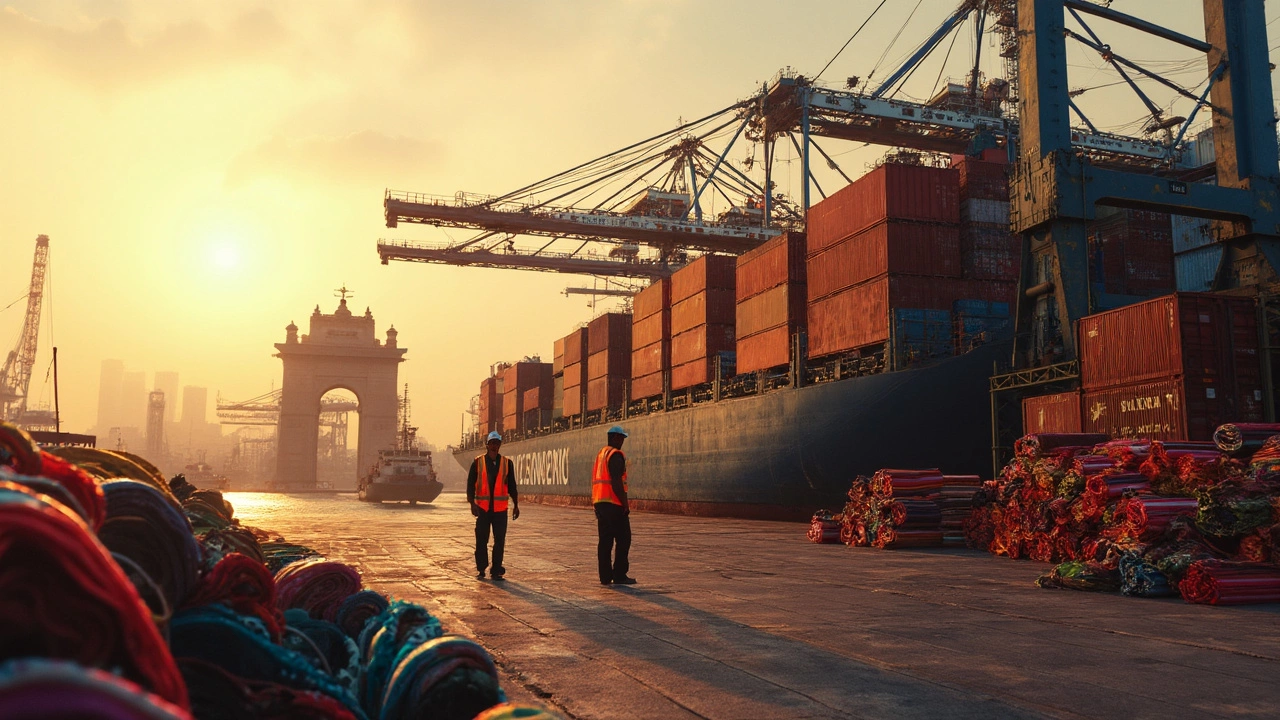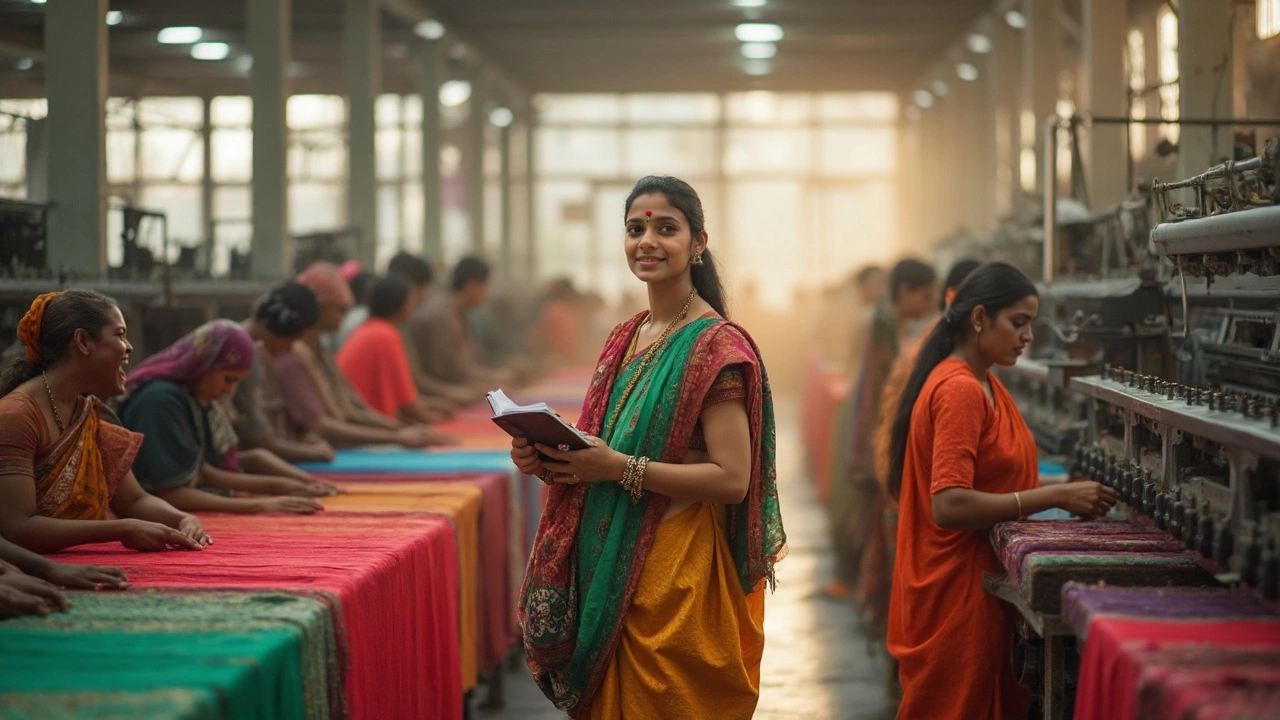If you’re in the textile game, you can’t ignore India—this country doesn’t just make fabrics; it lives and breathes textile production every single day. The numbers don’t lie: India is the world’s second biggest textile producer, and the biggest player on the home field is Aditya Birla Group’s Grasim Industries. Yes, you read that right—Grasim isn’t just big, it’s a giant. They spin out everything from viscose and natural fibers to ready-to-wear garments, making waves in over 100 countries.
Wondering why Grasim stands out? It’s not just about churning out yarn. They’ve nailed quality control and sustainable practices that win over big brands across Europe and the US. They aren’t shy about throwing around huge numbers, either—just in the last financial year, their textile division raked in over $6 billion. They’re the folks behind trusted names like Birla Cellulose, which pops up in thousands of product labels worldwide.
- India’s Textile Industry at a Glance
- Who Holds the Top Spot?
- What Sets Them Apart
- Interesting Facts and Numbers
- Tips for Choosing Quality Textile Manufacturers
India’s Textile Industry at a Glance
If there’s one thing you should know, textile manufacturers in India aren’t just making shirts or saris—they're fueling the nation’s economy. The textile sector is the second-largest employer after agriculture, giving jobs to over 45 million people. That’s not just a stat; it’s a backbone for families across villages and cities.
When it comes to global supply, India is always in the picture. The country produces everything: from raw cotton and silk to fancy synthetic fibers. It doesn’t matter if you like traditional handlooms or modern fabrics; there’s a factory or workshop somewhere in India spinning it right now.
| Production Type | World Ranking (2024) | India’s Share |
|---|---|---|
| Cotton | 2nd | 23% |
| Jute | 1st | 60% |
| Textile Exports | 3rd | 6% |
It’s not just about domestic use either. Indian textile giants are major players in exports, sending goods to over 150 countries. Big brands? They buy Indian fabrics all the time, thanks to the massive variety and quality control. Cities like Surat, Tirupur, and Ludhiana are well known for being textile hubs—they practically run on spinning machines and printing presses.
Why does this matter? If you’re hunting for reliable partners or want to tap into a global supply chain, India's textile industry has the scale, tech, and history to back you up. The range is wild—think cotton basics, premium viscose, organic threads, denim, and much more. And despite new competition from other countries, Indian manufacturers keep pushing for better tech and sustainable methods to stay on top.
Who Holds the Top Spot?
If you ask anyone familiar with the largest textile industry India scene, one name keeps popping up: Grasim Industries Limited, part of the Aditya Birla Group. Out of all the big textile manufacturers India is famous for, Grasim blows the competition out of the water. They own a serious chunk of the market, mainly because of their scale, reach, and how they manage to get their products into pretty much every continent.
Grasim started way back in 1947 and has grown into a household name. They spearhead India’s viscose staple fiber (VSF) production with their famous Birla Cellulose brand. If you’re wearing a soft viscose shirt right now, there’s a good chance those fibers came from a Grasim mill. According to their 2024 financials, Grasim produced over 700,000 tons of VSF last year alone—no other Indian company comes close.
“Grasim Industries is now the world’s largest producer of viscose staple fiber and a global leader in sustainable cellulosic fibers,” reports The Economic Times in their 2024 industry summary.
This isn’t just about size. Grasim’s pollution controls, energy efficiency, and ethical sourcing have set new standards. They’re constantly winning awards for setting up closed-loop systems and cutting down on water waste. If you’re a fashion brand or retailer, knowing your supplier ticks all these boxes matters a lot.
They don’t just stick to fiber, either. The company is big into yarn, fabric, and even branded ready-made apparel. Here’s a quick snapshot of their latest numbers and output:
| Segment | Annual Output (2024) | Countries Exported To |
|---|---|---|
| Viscose Staple Fiber | 700,000 tons | 65+ |
| Yarn Spinning | 200,000 tons | 55+ |
| Branded Apparel | 80 million pieces | 40+ |
So, if you’re after the top dog among Indian textile giants, Grasim isn’t just leading—they’re setting the pace globally. For anyone looking to source or partner up in textiles, understanding what makes Grasim tick is a must.

What Sets Them Apart
So, what’s the secret sauce behind Grasim Industries ruling the largest textile industry India scene? First, it’s all about scale. They’re not working with small batches here. Their plants can churn out tons—literally—of viscose staple fiber every day, making them a heavyweight not just in India, but across Asia. No other textile manufacturers India can match their global reach combined with their footprint in the country.
Quality isn’t just a buzzword for them. Grasim’s Birla Cellulose gets certified for top-notch eco-friendly production. Ever heard of LIVA? That’s their eco-friendly fiber brand found in all sorts of clothes—tops, dresses, and even sporty wear. International labels like H&M and Zara actually source from Grasim because the raw material meets strict global standards. It’s not just about business; Grasim puts effort into sustainable manufacturing—cutting down water use and improving energy efficiency year after year.
Here’s something concrete: Grasim invests in R&D big time. They employ entire teams focused only on finding better, greener ways to make fibers and keep their costs low. That’s why they can offer competitive prices to buyers worldwide. Plus, Grasim’s supply chain is flexible—they handle their own raw materials, manufacturing, logistics, and even exports. This means faster turnaround, fewer delays, and more control over quality checks.
Check out these standout numbers from last year to get the picture:
| Key Metric | Value |
|---|---|
| Annual Textile Revenue | $6.2 billion |
| Employees | Over 19,000 |
| Production Sites | 10 in India, 3 overseas |
| Export Markets | 100+ countries |
| Annual Viscose Output | Nearly 600,000 tons |
If you’re scouting for reliability, competitive pricing, and serious global connections, Grasim is miles ahead in the textile manufacturers India race. They’re basically setting the bar for what a modern, massive textile company should look like—both inside India and on the world stage.
Interesting Facts and Numbers
You probably hear about India’s massive textile scene, but some facts just jump off the page when you zoom in on the largest textile industry in India. We’re talking serious scale and influence here.
Grasim Industries (under Aditya Birla Group) doesn’t just serve local markets—they reach over 100 countries, with a footprint from Asia to Europe to the Americas. Their textile division alone saw revenue shoot past 50,000 crore INR (that’s about $6 billion) last year. And here’s a shocker: one in every four garments made with viscose in the world uses Birla Cellulose fiber. That’s a lot of closets counting on Indian textiles.
| Key Metric | Grasim (Birla Cellulose) |
|---|---|
| Annual Production Capacity | Over 700,000 tons of fiber |
| Global Market Share (Viscose) | Nearly 21% |
| Exports | To more than 100 countries |
| Employees | 25,000+ |
| Revenue FY24 | ₹50,000 crore (~$6B) |
Want to talk about sustainability? Birla Cellulose’s big claim is making viscose from wood pulp that’s certified and traceable. They’ve cut their water and energy use way below industry averages. That means you get safe, quality materials with a smaller carbon footprint—a growing demand from major brands these days.
If you’re tracking textile exports, here’s a key point: textile manufacturers in India shipped out goods worth about $44 billion in 2024, and Grasim’s basket played a major part in that number. Their growth helps push India’s status higher on the global textile map.
- The company operates 11 manufacturing plants in India alone.
- They pump out not just viscose, but also modal, lyocell, and even innovative eco-friendly blends.
- They partner with more than 300 brands to reach consumers worldwide.
So, if you’re sizing up big names in the textile industry, Grasim Industries’ numbers speak for themselves. This is what scale, consistency, and forward-thinking in India’s textile market really look like.

Tips for Choosing Quality Textile Manufacturers
Picking the right partner in India’s textile world takes more than a few Google searches, especially when you want to work with the largest textile industry India or spot the top textile manufacturers India for your line. Here’s how you separate the pros from the rest.
- Check Certifications: Reliable textile giants like Grasim Industries don’t just talk the talk—they have big-league certifications. Look for ISO, Oeko-Tex, and GOTS labels. These mean the factory is serious about quality and safety.
- Dig Into Product Range: The bigger the range, the more likely you’re dealing with a heavy-hitter. Grasim pumps out viscose, modal, linen—if your manufacturer only does basic cotton, that’s a limit you’ll notice fast.
- Tour the Facility (Even Virtually): Most top Indian textile giants are proud to show you their setup. A factory visit—even over video—tells you how they handle cutting, dyeing, and safety. Shady setups avoid this step.
- Get References: Ask for names of brands that work with them. If you spot big buyers like H&M, Zara, or Arvind Mills, it’s a good sign. Big brands like these don’t take risks on flaky suppliers.
- Watch for Innovation: The textile production India scene moves fast on things like sustainable fibers and water-saving tech. Companies like Birla Cellulose publish yearly sustainability reports—look for manufacturers doing the same.
Still not convinced? Just look at who they export to. Here’s a quick comparison of export destinations for India’s largest manufacturers:
| Manufacturer | Top Export Destinations | Main Product Focus |
|---|---|---|
| Grasim Industries | USA, UK, Germany | Viscose Staple Fibre, Yarn |
| Arvind Limited | Japan, Bangladesh, Turkey | Denim, Woven Fabrics |
| Vardhman Textiles | Europe, China, South Korea | Cotton Yarn, Acrylics |
Picking from the textile export leaders in India means more than just chasing the lowest price. It’s about experience, reliability, and proven global connections. Don’t skip on research—your quality (and sanity) depend on it.
